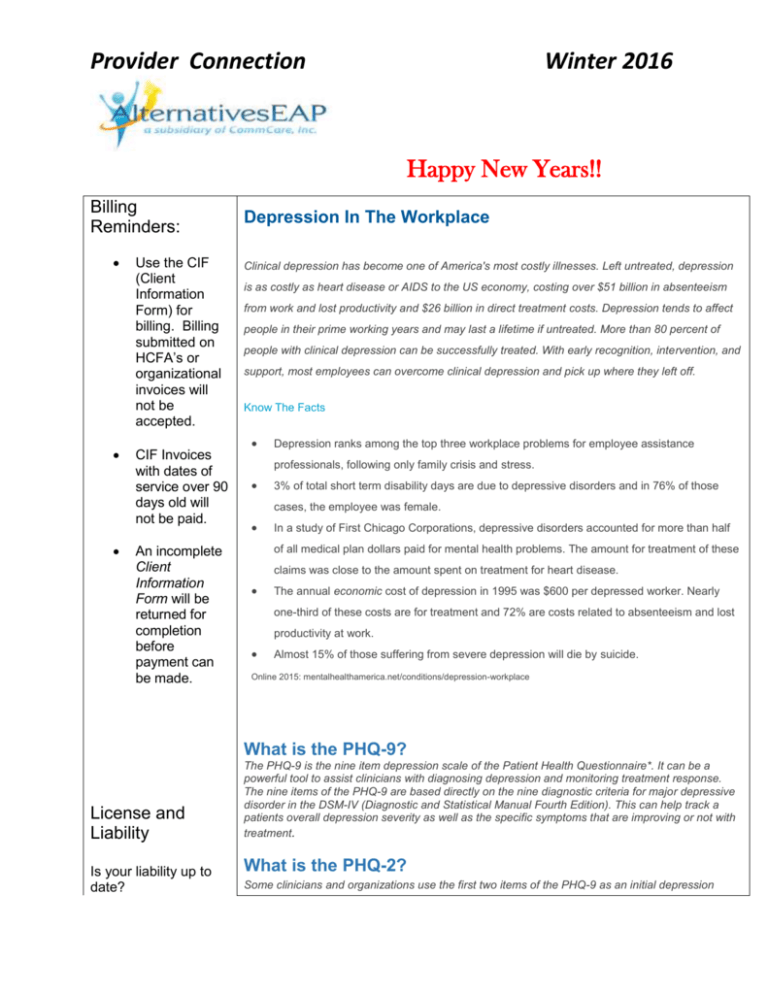Provider Newsletter
advertisement

Provider Connection Winter 2016 Happy New Years!! Billing Reminders: Use the CIF (Client Information Form) for billing. Billing submitted on HCFA’s or organizational invoices will not be accepted. CIF Invoices with dates of service over 90 days old will not be paid. An incomplete Client Information Form will be returned for completion before payment can be made. Depression In The Workplace Clinical depression has become one of America's most costly illnesses. Left untreated, depression is as costly as heart disease or AIDS to the US economy, costing over $51 billion in absenteeism from work and lost productivity and $26 billion in direct treatment costs. Depression tends to affect people in their prime working years and may last a lifetime if untreated. More than 80 percent of people with clinical depression can be successfully treated. With early recognition, intervention, and support, most employees can overcome clinical depression and pick up where they left off. Know The Facts Depression ranks among the top three workplace problems for employee assistance professionals, following only family crisis and stress. 3% of total short term disability days are due to depressive disorders and in 76% of those cases, the employee was female. In a study of First Chicago Corporations, depressive disorders accounted for more than half of all medical plan dollars paid for mental health problems. The amount for treatment of these claims was close to the amount spent on treatment for heart disease. The annual economic cost of depression in 1995 was $600 per depressed worker. Nearly one-third of these costs are for treatment and 72% are costs related to absenteeism and lost productivity at work. Almost 15% of those suffering from severe depression will die by suicide. Online 2015: mentalhealthamerica.net/conditions/depression-workplace What is the PHQ-9? License and Liability Is your liability up to date? The PHQ-9 is the nine item depression scale of the Patient Health Questionnaire*. It can be a powerful tool to assist clinicians with diagnosing depression and monitoring treatment response. The nine items of the PHQ-9 are based directly on the nine diagnostic criteria for major depressive disorder in the DSM-IV (Diagnostic and Statistical Manual Fourth Edition). This can help track a patients overall depression severity as well as the specific symptoms that are improving or not with treatment. What is the PHQ-2? Some clinicians and organizations use the first two items of the PHQ-9 as an initial depression Provider Connection Winter 2016 Please make sure we screening. If the patient responds affirmatively to either of these two items, the remaining 7 items have your updated are asked. This can be an efficient way to screen large groups of patients to improve detection of information. undiagnosed depression. Alternatives Li, MM, Friedman, B, Conwell, Y, Fiscella, K. Validity of the Patient Health Questionnaire 2 (PGQ-2) in Identifying Major will send a Depression in Older People. Journal of the American Geriatric Society. 2007; 55:596-602 reminder that your license or liability is Alternatives to the PHQ-9 coming due approximately Several depression screening 3-4 weeks instruments have been developed and before it is set validated for use in primary care and to expire. other settings. Instruments vary by If the updated whether they are self- or interviewerinformation is reported and applicable to patients with not received by cognitive or language barriers. expiration date, The Geriatric Depression we will contact Scale you by phone. This self-report instrument has been If we still have studied in multiple settings. There is a not received five-item version and a 15-item version the requested of this measure. (The 15-item measure information has excellent psychometric properties Alternatives when compared to a structured will deactivate diagnostic instrument in a sample of provider panel functionally impaired, cognitively intact, status. community-dwelling primary care Please fax patients.) updated information to: The Center for Epidemiologic 816.472.9016 Studies Depression Scale This is one of the most common instruments applied in community studies and also used in primary care settings. Alternatives will be moving to CAQH in 2016. Appointments Please return member calls Cornell Scale for Depression in Dementia This incorporates both observer and informant based information and is helpful in evaluating cognitively impaired patients for depression. Advantages of the PHQ-9 Provider Connection within 24 hours. We ask that you have appointment availability within 3-7 business days. Winter 2016 This tool: Is shorter than other depression rating scales, Can be administered in person, by telephone, or self-administered, Facilitates diagnosis of major depression, Provides assessment of symptom severity, Has proven effective in a geriatric population, (Löewe B,et al, 2004 Medical Care) Is well validated and documented in a variety of populations Scoring Research has shown that certain scores on the PHQ-9 are strongly correlated with a subsequent major depression diagnosis. However, not everyone with an elevated PHQ-9 is certain to have major depression. The PHQ-9 is intended as a tool to assist clinicians with identifying and diagnosing depression but is not a substitute for diagnosis by a trained clinician. Online 2015: impact–uw.org, IMPACT evidence based depression care. Aims Center, University of Washington Psychiatry and Behavioral Sciences No permission required to reproduce, translate, display or distribute is required. For a copy of the phq9, go to http://www.agencymeddirectors.wa.gov/Files/depressionform.pdf







